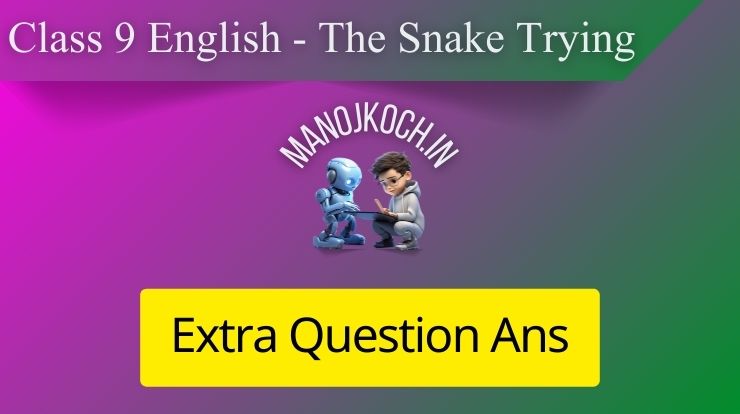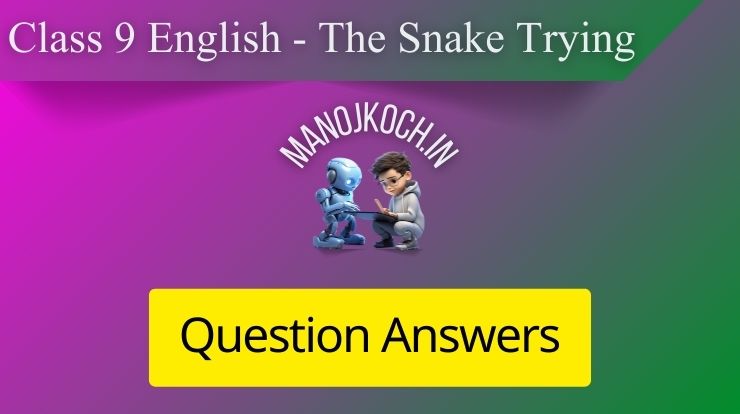The Snake Trying
Table of Contents

The Snake Trying MCQs
1. What does the poet feel towards the snake in the poem?
a) Fear
b) Curiosity
c) Admiration and sympathy
d) Anger
Answer: c) Admiration and sympathy
2. What is the snake trying to escape from in the poem?
a) The heat of the sun
b) A crow
c) A stick-wielding person
d) Another snake
Answer: c) A stick-wielding person
3. How does the poet describe the movements of the snake?
a) Aggressive and quick
b) Beautiful and graceful
c) Slow and lazy
d) Clumsy
Answer: b) Beautiful and graceful
4. According to the poem, where does the snake finally escape to?
a) A hole in the ground
b) A nearby tree
c) Beneath the water of a pond
d) Under a rock
Answer: c) Beneath the water of a pond
5. What does the poet ask the pursuer to do?
a) Kill the snake quickly
b) Admire the snake from a distance
c) Let the snake go and not harm it
d) Capture the snake carefully
Answer: c) Let the snake go and not harm it
6. Which word in the poem describes the snake’s body?
a) Soft
b) Bright
c) Curving
d) Thin
Answer: c) Curving
7. What type of snake is mentioned in the poem?
a) Cobra
b) Python
c) A green, harmless snake
d) Rattlesnake
Answer: c) A green, harmless snake
8. What emotion does the poet want to convey towards snakes in general?
a) Fear
b) Respect and understanding
c) Disgust
d) Superiority
Answer: b) Respect and understanding
9. Which line from the poem suggests that the snake is harmless?
a) “O let him go”
b) “And now he vanishes in ripples among the green slim reeds”
c) “He is harmless even to children”
d) “The snake trying to escape the pursuing stick”
Answer: c) “He is harmless even to children”
10. The poet’s use of the phrase “graceful and beautiful” in describing the snake indicates the poet’s perspective.
a) The poet fears the snake’s beauty
b) The poet admires the snake’s elegance
c) The poet finds the snake mysterious and creepy
d) The poet wants to avoid the snake at all costs
Answer: b) The poet admires the snake’s elegance

The Snake Trying Extra Answer Questions
1. What is the snake trying to do in the poem?
The snake is trying to escape from a person who is chasing it with a stick.
2. How does the poet feel about the snake?
The poet feels admiration and sympathy for the snake and wants it to be spared from harm.
3. Why does the poet ask the person to stop attacking the snake?
The poet asks the person to stop attacking the snake because it is harmless and beautiful, and there is no need to hurt it.
4. Describe how the snake moves, according to the poem.
The snake moves gracefully, curving and gliding with ease, which the poet describes as beautiful.
5. Where does the snake go to find safety?
The snake finds safety by slipping into the water among the green reeds, away from the reach of the stick.
Addition Answer Questions
1. How does the poet portray the snake in the poem? What effect does this portrayal have on the reader?
The poet portrays the snake as a harmless and graceful creature, describing its movement as “beautiful and graceful” as it tries to escape. This sympathetic portrayal helps to evoke empathy in the reader, encouraging them to see the snake as a delicate and vulnerable creature rather than something to fear or harm.
2. Explain the significance of the line, “He is harmless even to children.”
The line, “He is harmless even to children,” emphasizes that the snake poses no threat to anyone, not even the most vulnerable. This line challenges the common fear and hostility toward snakes, suggesting that not all snakes are dangerous and that they should be appreciated for their beauty and harmlessness. It reflects the poet’s message of compassion and understanding towards all creatures.
3. What message is the poet trying to convey about humans’ interaction with nature through this poem?
The poet conveys a message of respect and non-violence towards nature, encouraging people not to harm innocent creatures. By describing the snake as graceful and harmless, the poet challenges the reader to overcome fear and aggression towards animals, promoting coexistence and appreciation for all forms of life.
4. How does the setting of the poem contribute to its themes?
The setting of the poem—a natural environment with a pond and reeds—highlights the snake’s rightful place in nature, where it should be free from harm. The tranquil setting contrasts with the violence of the person chasing it with a stick, reinforcing the theme of peaceful coexistence and the need to protect, rather than disrupt, wildlife in their natural habitats.
5. What do you think the poet is trying to make the reader feel toward snakes by the end of the poem?
By the end of the poem, the poet is trying to make the reader feel compassion and appreciation for snakes, viewing them as beautiful, harmless creatures rather than as threats. The poet encourages readers to let go of unnecessary fears and adopt a gentler perspective towards wildlife.
Long Questions and Answers
1. What is the summary of the poem “The Snake Trying”?
The poem “The Snake Trying” by W.W.E. Ross describes a snake’s attempt to escape from a person pursuing it with a stick. The snake moves quickly and gracefully to avoid harm, eventually slipping into the water and finding safety among the reeds. The poet urges compassion, highlighting the snake’s harmless nature and admiring its beauty and elegance. The poem conveys a message against unnecessary violence toward creatures that pose no threat to humans.
2. What is the snake trying to escape from?
The snake is trying to escape from a person who is chasing it with a stick, intending to kill or harm it.
3. What does the poet think of snakes?
The poet admires the snake’s grace and beauty and considers it harmless. He sympathizes with the snake and suggests that it should be spared from harm, showing a compassionate attitude towards it.
4. Who is the poet of “The Snake Trying”?
The poet of “The Snake Trying” is W.W.E. Ross, a Canadian poet known for his nature-inspired works and appreciation of simple yet vivid descriptions.
5. Who chased the snake in the poem?
In the poem, an unnamed person chases the snake with a stick, trying to harm it. This person’s actions prompt the poet to express sympathy for the snake and to advocate for its safety.
6. What is the explanation of “The Snake Trying”?
“The Snake Trying” depicts a scene where a snake is pursued by someone with a stick. The poet observes the snake’s swift, graceful movements as it attempts to escape. Rather than fearing the snake, the poet appreciates its harmlessness and beauty, encouraging the reader to spare it. Through this, the poet conveys a message about respecting wildlife and avoiding unnecessary cruelty toward creatures that are not dangerous.
7. What poetic devices are used in “The Snake Trying”?
The poem uses several poetic devices, including:
- Imagery: Vivid descriptions of the snake’s movement help readers visualize the scene, such as “glides,” “curves,” and “slides.”
- Alliteration: The repetition of consonant sounds, such as in “beautiful and graceful.”
- Personification: The snake is portrayed with qualities like grace and dignity, helping readers empathize with it.
- Metaphor: The snake’s movement is metaphorically compared to graceful shapes and motions, adding beauty to its portrayal.
- Repetition: Words and phrases like “escape” are repeated to emphasize the snake’s struggle and urgency.

Thinking about the Poem
I. Answer the following questions:
- What is the snake trying to escape from?
The snake is trying to escape from a person who is chasing it with a stick, intending to harm or kill it. - Is it a harmful snake? What is its colour?
No, it is not a harmful snake. The poem describes it as green in colour, suggesting it may be a harmless garden or water snake. - The poet finds the snake beautiful. Find the words he uses to convey its beauty.
The poet uses words like “beautiful” and “graceful” to describe the snake’s movement. He also mentions its “curving” shapes, which highlight its elegance as it glides through the water. - What does the poet wish for the snake?
The poet wishes that the snake escapes safely and reaches a place where it will not be harmed. - Where was the snake before anyone saw it and chased it away? Where does the snake disappear?
The snake was lying quietly in the sun before anyone noticed it. When chased, it escapes into the water and disappears among the reeds, finding safety there.
II. Research and Exploration:
- Find out as much as you can about different kinds of snakes. Are they all poisonous? Find out the names of some poisonous snakes.
Not all snakes are poisonous. While some are venomous and dangerous to humans, many are harmless. Examples of poisonous snakes include:
- Cobra
- Viper
- Krait
- Rattlesnake Many snakes, such as grass snakes, water snakes, and pythons, are non-venomous and pose no threat to humans.
- Look for information on how to find out whether a snake is harmful.
One way to determine if a snake is harmful is by observing specific physical traits, although these methods are not always reliable and should be approached with caution. Common indicators include:
- Shape of the head: Venomous snakes often have a triangular or diamond-shaped head.
- Pupil shape: Venomous snakes often have vertical, slit-like pupils, while non-venomous snakes usually have round pupils.
- Color patterns: Some venomous snakes have distinct colour patterns or markings, although this is not a definitive method.
If unsure, it is always best to avoid handling any snake and seek expert assistance.
- Find out about people in our country who have traditional knowledge about snakes and can catch them with bare hands.
In India, the Sapera or Jogi Nath communities are well-known for their traditional knowledge of snakes. Snake charmers from these communities have long handled snakes, including venomous ones, with skill and care. They use their knowledge to rescue snakes from urban areas and sometimes even perform snake charming. Despite legal restrictions, their knowledge is valued in fields such as snake rescue, first aid for snake bites, and traditional medicine.